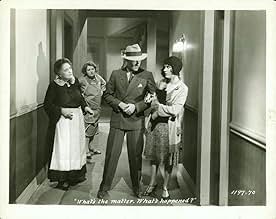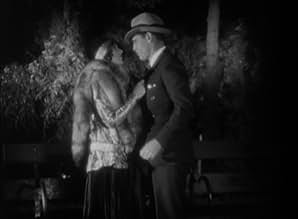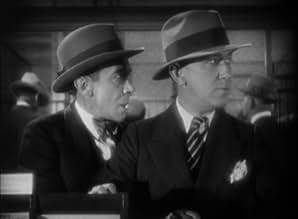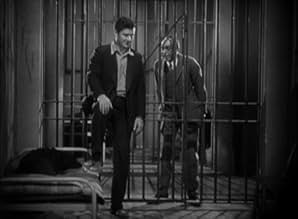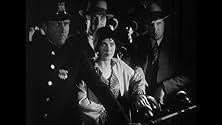VALUTAZIONE IMDb
6,5/10
992
LA TUA VALUTAZIONE
Thunderbolt, noto criminale, rischia l'esecuzione. Nella cella accanto c'è l'innocente Bob Moran, innamorato della ragazza di Thunderbolt. Questi spera di avere abbastanza tempo per poter uc... Leggi tuttoThunderbolt, noto criminale, rischia l'esecuzione. Nella cella accanto c'è l'innocente Bob Moran, innamorato della ragazza di Thunderbolt. Questi spera di avere abbastanza tempo per poter uccidere Moran.Thunderbolt, noto criminale, rischia l'esecuzione. Nella cella accanto c'è l'innocente Bob Moran, innamorato della ragazza di Thunderbolt. Questi spera di avere abbastanza tempo per poter uccidere Moran.
- Regia
- Sceneggiatura
- Star
- Candidato a 1 Oscar
- 2 vittorie e 1 candidatura in totale
Ernie Adams
- Thug in Bank at Robbery
- (non citato nei titoli originali)
Elmer Ballard
- Prisoner #8
- (non citato nei titoli originali)
Louise Beavers
- Black Cat Cafe Patron
- (non citato nei titoli originali)
Ed Brady
- Chuck - 1st Prisoner #5
- (non citato nei titoli originali)
Recensioni in evidenza
This film begins with the news that an elusive gangster nicknamed "Thunderbolt" (George Bancroft) is wanted for bank robbery and is considered armed and dangerous. That being said, as the film continues it is also revealed that Thunderbolt has a girlfriend named "Ritzi" (Fay Wray) that he is obsessed with. The problem is that Thunderbolt has become, not only extremely possessive of Ritzi, but somewhat abusive as well. So, because of that, Ritzi has since fallen in love with a gentle man named "Bob Moran" (Richard Arlen) who simply adores her. Needless to say, Thunderbolt becomes quite livid when he learns that Ritzi wants to break up with him because she has found another man. So much so that not even the death penalty can prevent him from getting his revenge. Now, rather than reveal any more, I will just say that I was pleasantly surprised with the menacing performance George Bancroft put in for this particular role. Absolutely outstanding. That being said, however, it's also quite obvious that all of the actors labored to some degree from the transition from silent films. An unfortunate byproduct of its time. Be that as it may, I still found this film to be entertaining for the most part and I have rated it accordingly. Slightly above average.
Sternberg's first Talkie is virtually a retread of his UNDERWORLD (1927), with the same leading man – George Bancroft – no less. However, while ably flanked by his co-stars there, he is practically the whole show this time around (Fay Wray and Richard Arlen being no match for Evelyn Brent and Clive Brook) and, consequently, the role earned Bancroft his sole Oscar nomination (and the film's as well)! Anyway, the director's approach to Sound was not as experimental as may have been anticipated (resorting to Death Row histrionics and even a number of songs to showcase the format!) and the end result is hardly dazzling in this regard – though the dialogue is surprisingly clean, i.e. audible, for such an early example. Conversely, the visual aspect of the film, usually the director's main concern, is greatly diluted here through the poor quality of the copy I watched which also sported forced German subtitles!
Bancroft is once again a gangster (as before, his activity remains undisclosed throughout, apart from lording it up in an almost exclusively-black nightclub!) and his moll eventually leaves him for another, younger and handsomer, man. Here, too, the mobster is caught and imprisoned – in a wonderful scene where he shows compassion for a mutt, subsequently proving inseparable, thus preceding Raoul Walsh's HIGH SIERRA by 12 years! Yet, he ingeniously has his associates frame the rival for a murder they committed (the development of this particular plot strand is unfortunately rather muddled) and the hero winds up in the cell opposite Bancroft's. As in UNDERWORLD, Fred Kohler also appears here to antagonize the latter – besides lanky warden Tully Marshall and an Irish guard whose name the protagonist continually tries to guess (with the droll pay-off coming at the film's very conclusion).
Wray and her mother plead with the gangster to do the right thing and clear Arlen of his crime but, of course, he will have none of that at the start. Again, however, Bancroft is softened and confesses his role in the young man's entrapment just hours before his execution is due; I have to wonder here why he, a first-time felon, is scheduled to die before the much sought-after "Thunderbolt"! – yes, the film's title is a reference to the character's nick-name. In any case, the moll's own admission that she had left her lover for the gangster rather than the other way around makes the latter realize, as was the case in UNDERWORLD, that he is in the way and gladly accepts his fate. Incidentally, speaking of references to the director's earlier work, Wray and Arlen are made to undergo a hasty marriage here – much like Bancroft himself and Betty Compson in THE DOCKS OF NEW YORK (1928)!
Bancroft is once again a gangster (as before, his activity remains undisclosed throughout, apart from lording it up in an almost exclusively-black nightclub!) and his moll eventually leaves him for another, younger and handsomer, man. Here, too, the mobster is caught and imprisoned – in a wonderful scene where he shows compassion for a mutt, subsequently proving inseparable, thus preceding Raoul Walsh's HIGH SIERRA by 12 years! Yet, he ingeniously has his associates frame the rival for a murder they committed (the development of this particular plot strand is unfortunately rather muddled) and the hero winds up in the cell opposite Bancroft's. As in UNDERWORLD, Fred Kohler also appears here to antagonize the latter – besides lanky warden Tully Marshall and an Irish guard whose name the protagonist continually tries to guess (with the droll pay-off coming at the film's very conclusion).
Wray and her mother plead with the gangster to do the right thing and clear Arlen of his crime but, of course, he will have none of that at the start. Again, however, Bancroft is softened and confesses his role in the young man's entrapment just hours before his execution is due; I have to wonder here why he, a first-time felon, is scheduled to die before the much sought-after "Thunderbolt"! – yes, the film's title is a reference to the character's nick-name. In any case, the moll's own admission that she had left her lover for the gangster rather than the other way around makes the latter realize, as was the case in UNDERWORLD, that he is in the way and gladly accepts his fate. Incidentally, speaking of references to the director's earlier work, Wray and Arlen are made to undergo a hasty marriage here – much like Bancroft himself and Betty Compson in THE DOCKS OF NEW YORK (1928)!
During the early days of talkies, dialogue writers were in great demand, and many who made the move to California were involved in the Broadway theater industry. The first regular theater critic for The New Yorker, Herman Mankiewicz, was soon in high demand in Hollywood after synchronized sound was introduced to cinema. A prime example of Mankiewicz's style was his screenplay in the early talkie, June 1929 "Thunderbolt." In 1927 Paramount Pictures hired Mankiewicz to write scenarios for its silent films. The studio asked him to work his connections for New York City writers to compose film scripts when talkies arrived. "Most of the newer writers on Paramount's staff who contributed the most successful stories of the past year (1929) were selected by 'Mank,'" wrote film critic Pauline Kael. Herman was the subject in the Netflix 2020 biopic, "Mank."
Mankiewicz's famous telegram to Ben Hecht describes how desperate movie studios were to hire good writers. "Millions are to be grabbed out here and your only competition is idiots. Don't let this get around."
Mankiewicz was the highest-paid writer in Tinseltown. Kael described, "His heroes weren't soft-eyed and bucolic; he brought good-humored toughness to the movies, and energy and astringency. And the public responded, because it was eager for modern American subjects." In "Thunderbolt," adapted from a Charles and Jules Furthman story, Mankiewicz's script focuses on Jim Lang (George Bancroft), nicknamed Thunderbolt, wanted by the police. His girlfriend, 'Ritzy' (Fay Wray), is seeing banker Bob Moran (Richard Arlen) behind Jim's back. Lang is captured and is headed for the chair. In jail, he discovers who Ritzy's boyfriend is and frames Bob in a cop's murder. When arrested and sentenced, Bob finds himself in the jail cell next to Thunderbolt.
"Thunderbolt" was the type of movie designed for director Josef von Sternberg for his first talkie. The silent movie director of 1927's "Underworld," which introduced the gangster genre, was excited to be making talkies. He said he was "no longer at the mercy of movie house organists."
Sternberg especially loved to mix music with his actors' dialogue. In a classic nightclub scene, singer actress Theresa Harris, in her film debut, belts out a song while Thunderbolt and Ritzy are in an argument. Between Harris' numbers, the jazz band plays in the background while tension builds between Lang and nearby loud customers. The tense sequence reveals the inner turmoil of Thunderbolt. Film critic Andrew Sarris notes, "'Thunderbolt' is, in some respects, as much a musical as a melodrama." Sternberg was praised overseas for his film, receiving a telegram from German director Ludwig Berger, stating "I saw your film 'Thunderbolt' and congratulate you with all my heart. It is the first fully realized and artistically accomplished sound film. Bravo!" "Thunderbolt" was the second talkie for actor George Bancroft, his first was the now lost 1929 'The Wolf of Wall Street.' The actor earned a Best Actor Academy Award nomination for his role as Thunderbolt.
The future was bright for Mankiewicz, working alongside his younger brother, Joseph, who wrote the titles in "Thunderbolt." Herman is known by today's movie fans as the first screenwriter for 1939's "The Wizard of Oz," and for his collaboration with Orson Welles in 1941's "Citizen Kane."
Mankiewicz's famous telegram to Ben Hecht describes how desperate movie studios were to hire good writers. "Millions are to be grabbed out here and your only competition is idiots. Don't let this get around."
Mankiewicz was the highest-paid writer in Tinseltown. Kael described, "His heroes weren't soft-eyed and bucolic; he brought good-humored toughness to the movies, and energy and astringency. And the public responded, because it was eager for modern American subjects." In "Thunderbolt," adapted from a Charles and Jules Furthman story, Mankiewicz's script focuses on Jim Lang (George Bancroft), nicknamed Thunderbolt, wanted by the police. His girlfriend, 'Ritzy' (Fay Wray), is seeing banker Bob Moran (Richard Arlen) behind Jim's back. Lang is captured and is headed for the chair. In jail, he discovers who Ritzy's boyfriend is and frames Bob in a cop's murder. When arrested and sentenced, Bob finds himself in the jail cell next to Thunderbolt.
"Thunderbolt" was the type of movie designed for director Josef von Sternberg for his first talkie. The silent movie director of 1927's "Underworld," which introduced the gangster genre, was excited to be making talkies. He said he was "no longer at the mercy of movie house organists."
Sternberg especially loved to mix music with his actors' dialogue. In a classic nightclub scene, singer actress Theresa Harris, in her film debut, belts out a song while Thunderbolt and Ritzy are in an argument. Between Harris' numbers, the jazz band plays in the background while tension builds between Lang and nearby loud customers. The tense sequence reveals the inner turmoil of Thunderbolt. Film critic Andrew Sarris notes, "'Thunderbolt' is, in some respects, as much a musical as a melodrama." Sternberg was praised overseas for his film, receiving a telegram from German director Ludwig Berger, stating "I saw your film 'Thunderbolt' and congratulate you with all my heart. It is the first fully realized and artistically accomplished sound film. Bravo!" "Thunderbolt" was the second talkie for actor George Bancroft, his first was the now lost 1929 'The Wolf of Wall Street.' The actor earned a Best Actor Academy Award nomination for his role as Thunderbolt.
The future was bright for Mankiewicz, working alongside his younger brother, Joseph, who wrote the titles in "Thunderbolt." Herman is known by today's movie fans as the first screenwriter for 1939's "The Wizard of Oz," and for his collaboration with Orson Welles in 1941's "Citizen Kane."
If you can get past the really rather stilted production here - almost stage bound in it's presentation, this is quite an entertaining film that sees the authorities on the trail of the most wanted "Thunderbolt" (George Bancroft). He is elusive, though - and their only route to him might be through his ex-girfriend "Ritzie" (Fay Wray) - but she isn't playing ball for reasons of her own. It's only when "Thunderbolt" makes good on an earlier threat he made to her about seeing anyone else, that the police see some light. The performances are fine, not great but the writing is really quite good - plenty of quirky vernacular and it moves along well despite the frequent silent movie style direction and scene framing from Josef von Sternberg. There is also quite an enjoyable contribution from a blues ensemble and though certainly dated, this is still worth a watch almost 100 years later.
The High-Light of this "First-Year" of the All-Talkie Hollywood in Renowned Director Sternberg Film is the Harlem Night-Club.
This Takes Place in the First Half and while the Remainder of this Gangster-Romance is Peppered with a Few Interesting Flourishes,
None Equate the Impressive Opening and Once the Movie Gets to Prison the Film is Absent Sternberg's Signature Touches.
In Face the Movie Grinds to a Halt and is just Uninteresting Banter and Prison's Inanimate Existence.
The Dialog Deliveries are Pause Laden, Rhythmic Readings that are Stiff, Laborious, and so Wearily Dated as to be Painful.
Fay Wray is Hardly a Presence, Richard Arlen is OK, and George Bancroft (Oscar Nominated) is Domineering but Hardly Special.
Overall, a Curiosity and Film Historians Should Give it a Look for Context and the Director's Complete Filmography.
But Casual Movie Fans and Seekers of some "Old-Stuff" are Likely to be Bored to Death and Very Disappointed.
This Takes Place in the First Half and while the Remainder of this Gangster-Romance is Peppered with a Few Interesting Flourishes,
None Equate the Impressive Opening and Once the Movie Gets to Prison the Film is Absent Sternberg's Signature Touches.
In Face the Movie Grinds to a Halt and is just Uninteresting Banter and Prison's Inanimate Existence.
The Dialog Deliveries are Pause Laden, Rhythmic Readings that are Stiff, Laborious, and so Wearily Dated as to be Painful.
Fay Wray is Hardly a Presence, Richard Arlen is OK, and George Bancroft (Oscar Nominated) is Domineering but Hardly Special.
Overall, a Curiosity and Film Historians Should Give it a Look for Context and the Director's Complete Filmography.
But Casual Movie Fans and Seekers of some "Old-Stuff" are Likely to be Bored to Death and Very Disappointed.
Lo sapevi?
- QuizOne of the earliest of over 700 Paramount productions, filmed between 1929 and 1949, which were sold to MCA/Universal in 1958 for television distribution, and have been owned and controlled by MCA ever since. However, because of its extreme age, and primitive sound recording techniques, there is no record of it ever having been locally televised. On cable TV it received what may have been its first and only telecast on Turner Classic Movies in August 2016.
- Versioni alternativeMade in both sound and silent versions.
I più visti
Accedi per valutare e creare un elenco di titoli salvati per ottenere consigli personalizzati
- How long is Thunderbolt?Powered by Alexa
Dettagli
- Data di uscita
- Paese di origine
- Lingua
- Celebre anche come
- Thunderbolt
- Luoghi delle riprese
- Azienda produttrice
- Vedi altri crediti dell’azienda su IMDbPro
- Tempo di esecuzione1 ora 25 minuti
- Colore
Contribuisci a questa pagina
Suggerisci una modifica o aggiungi i contenuti mancanti


